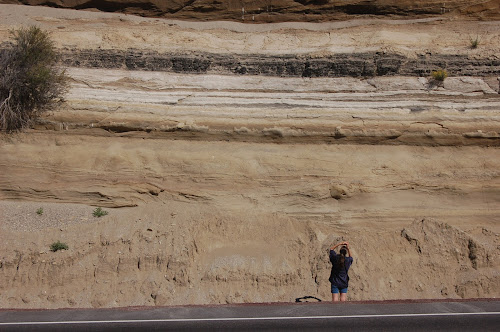Same outcrop as yesterday's showing a better overview of a lower portion of the pile. One of the nice things about this spot is that it's a fairly long cut, several hundred feet, and the grade is about as maximally steep as you'd want a major highway to be. As a result, you can walk through a very interesting sequence of lacustrine strata.
I'm not enough of a sedimentologist, I don't think, to have concluded that this is indeed a lacustrine sequence- I know I wasn't when I was told by Sharkey, on a sixty-five mile per hour reconnaissance drive-by, that that is what we were seeing. It's possible, however, that even if I hadn't known, finally stopping after many, many such drive-bys over the years (Mostly south-bound, with kids, neither of which made this a sensible stop), and looking carefully at the rock types for the first time, I might have come to the correct conclusion.
The buff and brown layers dominant in the lower portion and at the very top are tuffaceous silts and sands, with varying degrees of sorting. There are a variety of sedimentary structures, primary and secondary, in these layers. Primary structures include lots of cross-bedding, numerous cut-and-fill structures, and some ripple cross lamination. Secondary structures include all kinds of soft sediment deformation, including some ball-and-pillow structures. The bright white layers are diatomite, and the black is low-grade coal- I have been calling it lignite.
Now diatomite and lignite aren't "by definition" deposited in lake environments, but they strongly indicate it. Given the geography of this spot, utterly flat orientation of the bedding, and the looseness of lithification, I feel confident in saying this can only be a few million years old- Pliocene, maybe. So it can't be marine. It can't be fluvial, with that diatomite. What remains as a reasonable environment is lacustrine.
Photo unprocessed. August 18, 2011. FlashEarth location (cross-hairs on pull-out). If you choose to visit this spot, please see yesterday's safety comments. Also, this is pretty much non-geological, but might help you find the spot. This sign is at the lower end of the road cut. If you're headed south, you could go to one of these spots, turn back to the north, and hit the pull-outs from the safer direction.
Is This Your Hat?
11 years ago












No comments:
Post a Comment